Handheld Device-Based Indoor Localization with Zero Infrastructure (HDIZI)
Abstract
:1. Introduction
- We present a comprehensive literature review of the use of mobile-phone-embedded sensors in indoor localization and tracking;
- A literature comparison of the three main components (sensors, algorithms, and techniques) required for tracking and localizing an object in an indoor environment;
- We design a handheld-device-based indoor localization and tracking platform with zero infrastructure;
- We construct an initial dataset of multilayer data sources for indoor localization and tracking;
- We build a visualization of the connections between data sources using a Web of Things (WoT) technique (Node-RED) for routing data from different sensors.
2. Literature Review
2.1. Geospatial Environment
2.2. Machine Learning
2.3. Range-Based Localization Techniques
2.4. Pedestrian Dead-Reckoning (PDR) Techniques
2.5. Handheld Device Sensors
2.6. Web of Things
2.7. Model Development
3. Discussion
3.1. Sensors
| Sensor | Uses | Limitations | |
|---|---|---|---|
| Main sensors in the platform | Accelerometer [12,34,35,36,37,38,39] | Measures gravity, changes in capacitance, and acceleration and deceleration forces. | External acceleration errors, freely falling object acceleration problem. Cannot sense a 3D rotation. |
| Magnetometer [12,16,35] | Measures magnetic field, object’s north orientation, a complementary sensor | Disturbance in magnetic field. | |
| Gyroscope [12,30,34,35] | Maintains orientation and angular velocity. | Data drift (i.e., the orientation smoothly drifts away from the truth). | |
| Enhanced sensors | Proximity [40,41,42] | Detects the distance between an object and the phone, uses LED light and IR detection to sense the presence of nearby objects | Limited to 10 cm distances. |
| Pedometer (SIMI sensor) [43] | Step counter, based on acceleration sensor. | Errors caused by external accelerations, makes accelerometer-based tilting sensing unreliable. | |
| Ambient light [44] | Senses light level, proximity sensing. | ||
| Barometer [45] | Corrects altitude errors to narrow down the deviation to 1 m and works with the device’s GPS to locate position when inside a building. | Requires calibration by user. |
3.2. Algorithms
3.3. Techniques
3.4. Analysis of Indoor Localization and Tracking Parameters
4. Proposed Framework Structure
4.1. Sensor Smoothing
4.2. First Fusion
4.3. Sensor Fusion
5. Initial Data
5.1. Site One: Data Preparation
5.2. Site Two: Data Preparation
5.3. Raw Data Processing
5.4. WoT: Node-RED Data Processing
5.5. Design Flow and Nodes
5.6. Debug Data
5.7. Quick Response Layer
6. Conclusions and Future Work
Author Contributions
Funding
Institutional Review Board Statement
Informed Consent Statement
Data Availability Statement
Conflicts of Interest
References
- Kusens, M. Electronic Location Determination & Tracking System with Virtual Beacon Clustering. U.S. Patent 10,194,278, 29 January 2019. [Google Scholar]
- Friday, R.; Castagnoli, N.D.; Frei, R.W. Dynamic Virtual Beacon Methods and Apparatus. U.S. Patent 9967803B2, 8 May 2018. [Google Scholar]
- Smith, M.T. Virtual Beacon System. U.S. Patent 7231441B2, 12 January 2019. [Google Scholar]
- Hubner, P.V.; Charfauros, A.; Diego, S.; Sweeney, W.; Ridge, B. Providing a Message Based on Translating a Beacon Identifier to a Virtual Beacon Identifier. U.S. Patent 9565528B2, 7 February 2017. [Google Scholar]
- Zepeda, Y. Virtual Sensor Systems and Methods. WO2014108729A3, 17 July 2014. [Google Scholar]
- Zhang, Y.; Mao, L. A Virtual Beacon Node Algorithm Based on Pulse Ultra-Wideband. In Proceedings of the 2nd IEEE Advanced Information Management, Communicates, Electronic and Automation Control Conference (IMCEC), Xi’an, China, 25–27 May 2018; pp. 2617–2620. [Google Scholar] [CrossRef]
- Li, Y.K.; Shao, H.G.; Ni, S.Z. A Weighted Centroid Localization Algorithm Based on RSSI and Virtual Static Beacon Nodes. Adv. Mater. Res. 2014, 1077, 252–256. [Google Scholar] [CrossRef]
- Jose Alonso, Y.Z.; Gisele, B. Virtual Sensor Configuration. U.S. Patent 20180158244A1, 7 June 2018. [Google Scholar]
- Kim-Hung, L.; Datta, S.K.; Bonnet, C.; Hamon, F.; Boudonne, A. A Scalable IoT Framework to Design Logical Data Flow Using Virtual Sensor. In Proceedings of the IEEE 13th International Conference on Wireless and Mobile Computing, Networking and Communications (WiMob), Rome, Italy, 9–11 October 2017. [Google Scholar] [CrossRef]
- Alessi, M.; Giangreco, E.; Pinnella, M.; Pino, S.; Storelli, D.; Mainetti, L.; Mighali, V.; Patrono, L. A Web Based Virtual Environment as a Connection Platform between People and IoT. In Proceedings of the International Multidisciplinary Conference on Computer and Energy Science (SpliTech), Split, Croatia, 13–15 July 2016. [Google Scholar] [CrossRef]
- Lemos, M.; Rabelo, R.; Mendes, D.; Carvalho, C.; Holanda, R. An Approach for Provisioning Virtual Sensors in Sensor Clouds. Int. J. Netw. Manag. 2019, 29, e2062. [Google Scholar] [CrossRef]
- Mumtaz, N.; Arif, S.; Qadeer, N.; Khan, Z.H. Development of a Low Cost Wireless IMU Using MEMS Sensors for Pedestrian Navigation. In Proceedings of the International Conference on Communication, Computing and Digital Systems (C-CODE), Islamabad, Pakistan, 8–9 March 2017; pp. 310–315. [Google Scholar] [CrossRef]
- Cited, R.; Data, P.P. Virtual Machine Access Control in Mobile Computing Device Based on Positional Range from Beacon Signal. U.S. Patent 9,992,204, 5 June 2018. [Google Scholar]
- Hu, B.; Shi, Z.; Wang, Y. Single-Sensor Based Indoor Localisation by Exploiting Multipath Propagation. Electron. Lett. 2018, 54, 179–181. [Google Scholar] [CrossRef]
- Guzmán, C.H.; Carrera, J.L.; Durán, H.A.; Berumen, J.; Ortiz, A.A.; Guirette, O.A.; Arroyo, A.; Brizuela, J.A.; Gómez, F.; Blanco, A.; et al. Implementation of Virtual Sensors for Monitoring Temperature in Greenhouses Using CFD and Control. Sensors 2019, 19, 60. [Google Scholar] [CrossRef] [PubMed]
- He, S.; Shin, K.G. Geomagnetism for Smartphone-Based Indoor Localization: Challenges, Advances, and Comparisons. ACM Comput. Surv. 2017, 50, 97. [Google Scholar] [CrossRef]
- Tondwalkar, A. Infrastructure-Less Collaborative Indoor Positioning for Time Critical Operations. In Proceedings of the 2015 IEEE Power, Communication and Information Technology Conference, PCITC 2015—Proceedings, Piscataway, NJ, USA, 21 March 2016; Institute of Electrical and Electronics Engineers Inc.: Piscataway, NJ, USA; pp. 834–838. [Google Scholar]
- Bhardwaj, A. Terrestrial and Satellite-Based Positioning and Navigation Systems—A Review with a Regional and Global Perspective. Eng. Proc. 2020, 2, 41. [Google Scholar] [CrossRef]
- Laoudias, C.; Moreira, A.; Kim, S.; Lee, S.; Wirola, L.; Fischione, C. A Survey of Enabling Technologies for Network Localization, Tracking, and Navigation. IEEE Commun. Surv. Tutorials 2018, 20, 3607–3644. [Google Scholar] [CrossRef]
- Mohammed, M.; Khan, M.B.; Bashie, E.B.M. Machine Learning: Algorithms and Applications; Routledge: London, UK, 2016; ISBN 9781498705394. [Google Scholar]
- Trinh, A.V.T.; Dinh, T.M.T.; Nguyen, Q.T.; Sandrasegaran, K. Indoor Positioning Using BLE IBeacon, Smartphone Sensors, and Distance-Based Position Correction Algorithm. Adv. Intell. Syst. Comput. 2020, 1125, 1007–1016. [Google Scholar] [CrossRef]
- Pipelidis, G.; Tsiamitros, N.; Gentner, C.; Ahmed, D.B.; Prehofer, C. A Novel Lightweight Particle Filter for Indoor Localization. In Proceedings of the International Conference on Indoor Positioning and Indoor Navigation (IPIN), Pisa, Italy, 30 September–3 October 2019. [Google Scholar] [CrossRef]
- Al-Sahly, A.M.; Al-Rubaian, M.; Al-Qurishi, M. Developing Soft-Beacon as a Service Based on Online-Offline Positioning. In Proceedings of the 2nd International Conference on Computer Applications and Information Security, ICCAIS 2019, Riyadh, Saudi Arabia, 1–3 May 2019. [Google Scholar]
- Acharyya, I.S.; Al-Anbuky, A. Towards Wireless Sensor Network Softwarization. In Proceedings of the IEEE NetSoft Conference and Workshops (NetSoft), Seoul, Korea, 6–10 June 2016; pp. 378–383. [Google Scholar] [CrossRef]
- Tan, X.; Sun, Z. Environment-Aware Indoor Localization Using Magnetic Induction. In Proceedings of the IEEE Global Communications Conference (GLOBECOM), San Diego, CA, USA, 6–10 December 2016; pp. 1–6. [Google Scholar] [CrossRef]
- Zhao, L.; Chen, W. Detection and Recognition of Human Body Posture in Motion Based on Sensor Technology. IEEJ Trans. Electr. Electron. Eng. 2020, 15, 766–770. [Google Scholar] [CrossRef]
- Daniel Bossér, J.; Sörstadius, E.; Chehreghani, M.H. Model-Centric and Data-Centric Aspects of Active Learning for Neural Network Models. arXiv 2009, arXiv:2009.10835. Available online: https://arxiv.org/abs/2009.10835 (accessed on 1 September 2021).
- van der Aalst, W.M.P.; Carmona, J. Process Mining Handbook. Springer: Berlin/Heidelberg, Germany. [CrossRef]
- Science, O.F. Virtual Sensor Apparatus and Method. CN107113565A, 26 October 2016. [Google Scholar]
- Bouffard, J.L. An Alternative Sensor Fusion Method for Object Orientation Using Low-Cost Mems Inertial Sensors. Master’s Thesis, The University of Vermont, Burlington, VT, USA, 2016. [Google Scholar]
- Hussein, A.J.; Riadh, A.; Alsultan, M.; Tareq, A.A.R. Applications and Design for a Cloud of Virtual Sensors. Indones. J. Electr. Eng. Comput. Sci. 2016, 2, 229–240. [Google Scholar] [CrossRef]
- Kang, K.; Park, J.; Hyoung, S.; Oh, J.Y. Methods and Systems for Operating a Logical Sensor Network. U.S. Patent 9,747,788 B2, 29 August 2017. [Google Scholar]
- Sarkar, C.; Rao, V.S.; Venkatesha Prasad, R.; Das, S.N.; Misra, S.; Vasilakos, A. VSF: An Energy-Efficient Sensing Framework Using Virtual Sensors. IEEE Sens. J. 2016, 16, 5046–5059. [Google Scholar] [CrossRef]
- Gui, P.; Tang, L.; Mukhopadhyay, S. MEMS Based IMU for Tilting Measurement: Comparison of Complementary and Kalman Filter Based Data Fusion. In Proceedings of the IEEE 10th Conference on Industrial Electronics and Applications (ICIEA), Auckland, New Zealand, 15–17 June 2015; pp. 2004–2009. [Google Scholar] [CrossRef]
- Islam, T.; Islam, M.S.; Shajid-Ul-Mahmud, M.; Hossam-E-Haider, M. Comparison of Complementary and Kalman Filter Based Data Fusion for Attitude Heading Reference System. AIP Conf. Proc. 2017, 1919, 020002. [Google Scholar] [CrossRef]
- Hassan, M.R.; Haque, M.S.M.; Hossain, M.I.; Hassan, M.M.; Alelaiwi, A. A Novel Cascaded Deep Neural Network for Analyzing Smart Phone Data for Indoor Localization. Future Gener. Comput. Syst. 2019, 101, 760–769. [Google Scholar] [CrossRef]
- Fasel, B.; Sporri, J.; Chardonnens, J.; Kroll, J.; Muller, E.; Aminian, K. Joint Inertial Sensor Orientation Drift Reduction for Highly Dynamic Movements. IEEE J. Biomed. Health Inform. 2018, 22, 77–86. [Google Scholar] [CrossRef]
- Elmquist, A. Virtual Sensing for Autonomous Vehicle Simulation in Chrono. 2016. Available online: https://www.projectchrono.org/assets/slides_3_0_0/6_OtherModules/6_ChronoCAVE.pdf (accessed on 23 January 2021).
- Gim, J.; Ahn, C. Imu-Based Virtual Road Profile Sensor for Vehicle Localization. Sensors 2018, 18, 3344. [Google Scholar] [CrossRef]
- Bolic, M.; Rostamian, M.; Djuric, P.M. Proximity Detection with RFID: A Step toward the Internet of Things. IEEE Pervasive Comput. 2015, 14, 70–76. [Google Scholar] [CrossRef]
- Kumar, S.; Gil, S.; Katabi, D.; Rus, D. Accurate Indoor Localization with Zero Start-up Cost. In Proceedings of the 20th Annual International Conference on Mobile Computing and Networking, Online, 7–11 September 2014; pp. 483–494. [Google Scholar] [CrossRef]
- Wanata, H.A.O.; Tilata, U.T.; Man, T.A.I.; Lim, M.A. Shelf with Integrated Electronics. U.S. Patent 10064502B1, 4 September 2018. [Google Scholar]
- Lee, S.; Chon, Y.; Cha, H. Smartphone-Based Indoor Pedestrian Tracking Using Geo-Magnetic Observations. Mob. Inf. Syst. 2013, 9, 123–137. [Google Scholar] [CrossRef]
- Pogorelik, O.; Priev, A. Virtual Sensor System. WO2017052788A1, 30 March 2017. [Google Scholar]
- Tobias, D. Indoor Positioning & Services. Infsoft Smart Connected Locations. Available online: https://whitepaper.infsoft.com/en/docs/infsoft-Whitepaper-EN.pdf?reload=1507727048510 (accessed on 23 January 2021).
- Li, Y.; Chen, C.P.; Maitlo, N.; Mi, L.; Zhang, W.; Chen, J. Deep Neural Network–Based Loop Detection for Visual Simultaneous Localization and Mapping Featuring Both Points and Lines. Adv. Intell. Syst. 2020, 2, 1900107. [Google Scholar] [CrossRef]
- Zhao, H.; Cheng, W.; Yang, N.; Qiu, S.; Wang, Z.; Wang, J. Smartphone-Based 3D Indoor Pedestrian Positioning through Multi-Modal Data Fusion. Sensors 2019, 19, 4554. [Google Scholar] [CrossRef]
- Heinzelman, W.R.; Chandrakasan, A.; Balakrishnan, H. Energy-Efficient Communication Protocol for Wireless Microsensor Networks. In Proceedings of the 33rd Annual Hawaii International Conference on System Sciences, Maui, HI, USA, 7 January 2000. [Google Scholar]
- Rocha, A.R.; Delicato, F.C.; Pirmez, L.; Gomes, D.G.; Souza, J.N. De A Fully-Decentralized Semantic Mechanism for Autonomous Wireless Sensor Nodes. J. Netw. Comput. Appl. 2016, 61, 142–160. [Google Scholar] [CrossRef]
- Chatterjee, S.; Sarkar, S.; Misra, S. Energy-Efficient Data Transmission in Sensor-Cloud. In Proceedings of the Applications and Innovations in Mobile Computing (AIMoC), Kolkata, India, 12–14 February 2015; pp. 68–73. [Google Scholar] [CrossRef]
- Dinh, T.; Kim, Y. An Efficient Sensor-Cloud Interactive Model for on-Demand Latency Requirement Guarantee. In Proceedings of the IEEE International Conference on Communications, Paris, France, 28 July 2017; Institute of Electrical and Electronics Engineers Inc.: Piscataway, NJ, USA. [Google Scholar]
- Dinh, T.; Kim, Y.; Lee, H. A Location-Based Interactive Model of Internet of Things and Cloud (IoT-Cloud) for Mobile Cloud Computing Applications. Sensors 2017, 17, 489. [Google Scholar] [CrossRef] [PubMed]
- Li, J.; Jin, J.; Yuan, D.; Zhang, H. Virtual Fog: A Virtualization Enabled Fog Computing Framework for Internet of Things. IEEE Internet Things J. 2018, 5, 121–131. [Google Scholar] [CrossRef]
- Chattopadhyay, M.; Chowdhury, D. Design and Performance Analysis of MEMS Capacitive Pressure Sensor Array for Measurement of Heart Rate. Microsyst. Technol. 2017, 23, 4203–4209. [Google Scholar] [CrossRef]
- Chauhan, V.K.; Dahiya, K.; Sharma, A. Problem Formulations and Solvers in Linear SVM: A Review. Artif. Intell. Rev. 2019, 52, 803–855. [Google Scholar] [CrossRef]
- Xu, G.; Meng, X. The MEMS IMU Error Modeling Analysis Using Support Vector Machines. In Proceedings of the Second International Symposium on Knowledge Acquisition and Modeling, Wuhan, China, 30 November–1 December 2009; Volume 1, pp. 335–337. [Google Scholar] [CrossRef]
- Link, J.Á.B.; Smith, P.; Viol, N.; Wehrle, K. FootPath: Accurate Map-Based Indoor Navigation Using Smartphones. In Proceedings of the International Conference on Indoor Positioning and Indoor Navigation, Guimaraes, Portugal, 21–23 September 2011. [Google Scholar]
- Soatti, G.; Nicoli, M.; Savazzi, S.; Spagnolini, U. Consensus-Based Algorithms for Distributed Network-State Estimation and Localization. IEEE Trans. Signal Inf. Process. over Networks 2017, 3, 430–444. [Google Scholar] [CrossRef]
- Iwashita, Y.; Stoica, A.; Nakashima, K.; Kurazume, R.; Torresen, J. Virtual Sensors Determined Through Machine Learning. In Proceedings of the World Automation Congress (WAC), Stevenson, WA, USA, 3–6 June 2018; Volume 2018, pp. 318–321. [Google Scholar] [CrossRef]
- Sen, A.; Modekurthy, V.P.; Dalvi, R.; Madria, S. A Sensor Cloud Test-Bed for Multi-Model and Multi-User Sensor Applications. In Proceedings of the IEEE Wireless Communications and Networking Conference, Doha, Qatar, 3–6 April 2016; pp. 1–7. [Google Scholar] [CrossRef]
- Mu, X.; Rheem, J.Y. Quiet Zone Enhancement for a Target Location Using an Improved Virtual Sensing Algorithm. Electron. 2017, 6, 76. [Google Scholar] [CrossRef] [Green Version]
- Dombi, J.; Dineva, A. Adaptive Savitzky-Golay Filtering and Its Applications. Int. J. Adv. Intell. Paradig. 2020, 16, 145–156. [Google Scholar] [CrossRef]
- Sciences, M. Real-Time Monitoring of Train Wheels and Track Conditions Based on the Time Series Analysis and Multivariate Data Analysis. Master’s Thesis, University of South-Eastern Norway, Notodden, Norway, 2022. [Google Scholar]
- Amr, M.N.; El Attar, H.M.; Abd El Azeem, M.H.; Badawy, H. El An Enhanced Indoor Positioning Technique Based on a Novel Received Signal Strength Indicator Distance Prediction and Correction Model. Sensors 2021, 21, 719. [Google Scholar] [CrossRef]
- Dellosa, R.M.; Fajardo, A.C.; Medina, R.P. Modified Fingerprinting Localization Technique of Indoor Positioning System Based on Coordinates. Indones. J. Electr. Eng. Comput. Sci. 2019, 15, 1345–1355. [Google Scholar] [CrossRef]
- Ramdani, N.; Zeinalipour-Yazti, D.; Karamousadakis, M.; Panayides, A. Towards Robust Methods for Indoor Localization Using Interval Data. In Proceedings of the IEEE International Conference on Mobile Data Management, Hong Kong, China, 1 June 2019; Institute of Electrical and Electronics Engineers Inc.: Piscataway, NJ, USA; Volume 2019, pp. 403–408. [Google Scholar]
- Lee, S.; McBride, J. Extended Object Tracking via Positive and Negative Information Fusion. IEEE Trans. Signal Process. 2019, 67, 1812–1823. [Google Scholar] [CrossRef]
- Gong, W.; Liu, J. RoArray: Towards More Robust Indoor Localization Using Sparse Recovery with Commodity WiFi. IEEE Trans. Mob. Comput. 2019, 18, 1380–1392. [Google Scholar] [CrossRef]
- Ashraf, I.; Bin Zikria, Y.; Hur, S.; Park, Y. A Comprehensive Analysis of Magnetic Field Based Indoor Positioning with Smartphones: Opportunities, Challenges and Practical Limitations. IEEE Access 2020, 8, 228548–228571. [Google Scholar] [CrossRef]
- Lee, J.S.; Huang, S.M. An Experimental Heuristic Approach to Multi-Pose Pedestrian Dead Reckoning Without Using Magnetometers for Indoor Localization. IEEE Sens. J. 2019, 19, 9532–9542. [Google Scholar] [CrossRef]
- Sun, M.; Wang, Y.; Xu, S.; Cao, H.; Si, M. Indoor Positioning Integrating PDR/Geomagnetic Positioning Based on the Genetic-Particle Filter. Appl. Sci. 2020, 10, 668. [Google Scholar] [CrossRef]
- Yu, N.; Li, Y.; Ma, X.; Wu, Y.; Feng, R. Comparison of Pedestrian Tracking Methods Based on Foot- and Waist-Mounted Inertial Sensors and Handheld Smartphones. IEEE Sens. J. 2019, 19, 8160–8173. [Google Scholar] [CrossRef]
- Sofianidis, I.; Serasidis, V.; Konstantakos, V.; Siozios, K. Application of Energy Efficient Filtering for UWB Indoor Positioning.
- Liu, T.; Kuang, J.; Ge, W.; Zhang, P.; Niu, X. A Simple Positioning System for Large-Scale Indoor Patrol Inspection Using Foot-Mounted INS, QR Code Control Points, and Smartphone. IEEE Sens. J. 2021, 21, 4938–4948. [Google Scholar] [CrossRef]
- Chiang, K.W.; Tsai, G.J.; Chang, H.W.; Joly, C.; EI-Sheimy, N. Seamless Navigation and Mapping Using an INS/GNSS/Grid-Based SLAM Semi-Tightly Coupled Integration Scheme. Inf. Fusion 2019, 50, 181–196. [Google Scholar] [CrossRef]
- Huang, H.; Li, W.; Luo, D.A.; Qiu, D.W.; Gao, Y. An Improved Particle Filter Algorithm for Geomagnetic Indoor Positioning. J. Sensors 2018, 2018, 5989678. [Google Scholar] [CrossRef]
- Klinker, F. Exponential Moving Average versus Moving Exponential Average. Math. Semesterberichte 2011, 58, 97–107. [Google Scholar] [CrossRef]
- Galván-Tejada, C.E.; Pablo García-Vázquez, J.; Galván-Tejada, J.I.; Rubén Delgado-Contreras, J.; Brena, R.F. Infrastructure-Less Indoor Localization Using the Microphone, Magnetometer and Light Sensor of a Smartphone. Sensors 2015, 15, 20355–20372. [Google Scholar] [CrossRef] [PubMed]
- Akram, B.A.; Akbar, A.H.; Kim, K.H. CEnsLoc: Infrastructure-Less Indoor Localization Methodology Using GMM Clustering-Based Classification Ensembles. Mob. Inf. Syst. 2018, 2018, 3287810. [Google Scholar] [CrossRef]
- Hamidi-Rad, S.; Lyons, K.; Goela, N. Infrastructure-Less Indoor Localization Using Light Fingerprints. In Proceedings of the IEEE International Conference on Acoustics, Speech and Signal Processing (ICASSP), New Orleans, LA, USA, 5–9 March 2017; pp. 5995–5999. [Google Scholar] [CrossRef]
- Trehard, G.; Boukallel, M.; Lamy-Perbal, S. Indoor Pedestrian Localisation Solution Based on Anemometry Sensor Integration with a Smartphone. In Proceedings of the International Conference on Indoor Positioning and Indoor Navigation (IPIN), Sydney, NSW, Australia, 13–15 November 2012. [Google Scholar] [CrossRef]
- Al Hafiz, A.; Hossain, S.; Roy, N. Infrastructure-Less Occupancy Detection and Semantic Localization in Smart Environments. In Proceedings of the 12th EAI International Conference on Mobile and Ubiquitous Systems: Computing, Networking and Services on 12th EAI International Conference on Mobile and Ubiquitous Systems: Computing, Networking and Services, Brussels, Belgium, 22–24 July 2015. [Google Scholar] [CrossRef]
- Wang, Y.T.; Zheng, R.; Zhao, D. Towards Zero-Configuration Indoor Localization Using Asynchronous Acoustic Beacons. In Proceedings of the IEEE Intl Conference on Computational Science and Engineering (CSE) and IEEE Intl Conference on Embedded and Ubiquitous Computing (EUC) and 15th Intl Symposium on Distributed Computing and Applications for Business Engineering (DCABES), Paris, France, 24–26 August 2017; pp. 32–39. [Google Scholar] [CrossRef]
- De Cillis, F.; De Simio, F.; Faramondi, L.; Inderst, F.; Pascucci, F.; Setola, R. Indoor Positioning System Using Walking Pattern Classification. In Proceedings of the 22nd Mediterranean Conference on Control and Automation, MED 2014, Palermo, Italy, 16–19 June 2014; Institute of Electrical and Electronics Engineers Inc.: Piscataway, NJ, USA; pp. 511–516. [Google Scholar]
- Pasricha, S.; Ugave, V.; Anderson, C.W.; Han, Q. LearnLoc: A Framework for Smart Indoor Localization with Embedded Mobile Devices. In Proceedings of the International Conference on Hardware/Software Codesign and System Synthesis (CODES+ISSS), Amsterdam, Netherlands, 4–9 October 2015; pp. 37–44. [Google Scholar] [CrossRef]
- Ashraf, I.; Hur, S.; Shafiq, M.; Kumari, S.; Park, Y. GUIDE: Smartphone Sensors-Based Pedestrian Indoor Localization with Heterogeneous Devices. Int. J. Commun. Syst. 2019, 32, e4062. [Google Scholar] [CrossRef]
- Lamy-Perbal, S.; Guenard, N.; Boukallel, M.; Landragin-Frassati, A. A HMM Map-Matching Approach Enhancing Indoor Positioning Performances of an Inertial Measurement System. In Proceedings of the International Conference on Indoor Positioning and Indoor Navigation (IPIN), Banff, AB, Canada, 13–16 October 2015. [Google Scholar] [CrossRef]
- Bilke, A.; Sieck, J. Using the Magnetic Field for Indoor Localisation on a Mobile Phone. In Lecture Notes in Geoinformation and Cartography; Springer: Berlin/Heidelberg, Germany, 2013; pp. 195–208. [Google Scholar]
- Zhuang, P.; Wang, D.; Shang, Y. SMART: Simultaneous Indoor Localization and Map Construction Using Smartphones. In Proceedings of the Joint Conference on Neural Networks, Barcelona, Spain, 18–23 July 2010. [Google Scholar]
- Trehard, G.; Lamy-Perbal, S.; Boukallel, M. Indoor Infrastructure-Less Solution Based on Sensor Augmented Smartphone for Pedestrian Localisation. In Proceedings of the 2012 Ubiquitous Positioning, Indoor Navigation, and Location Based Service, UPINLBS, Helsinki, Finland, 3–4 October 2012. [Google Scholar]
- Brena, R.F.; Aguileta, A.A.; Trejo, L.A.; Molino-Minero-Re, E.; Mayora, O. Choosing the Best Sensor Fusion Method: A Machine-Learning Approach. Sensors 2020, 20, 2350. [Google Scholar] [CrossRef]
- Faramondi, L.; Inderst, F.; Pascucci, F.; Setola, R.; Delprato, U. An Enhanced Indoor Positioning System for First Responders. In Proceedings of the International Conference on Indoor Positioning and Indoor Navigation, Montbeliard, France, 28–31 October 2013. [Google Scholar] [CrossRef]
- Ashraf, I.; Hur, S.; Park, Y. Enhancing Performance of Magnetic Field Based Indoor Localization Using Magnetic Patterns from Multiple Smartphones. Sensors 2020, 20, 2704. [Google Scholar] [CrossRef] [PubMed]
- Guo, H.; Uradzinski, M. The Usability of MTI IMU Sensor Data in PDR Indoor Positioning. In Proceedings of the 25th Saint Petersburg International Conference on Integrated Navigation Systems (ICINS), St. Petersburg, Russia, 28–30 May 2018; pp. 1–4. [Google Scholar] [CrossRef]
- Grayscale, O. Review on Quick Response Codes in the Field of Information Security. In Proceedings of the International Conference on Advances in Engineering and Technology (ICAET), Nagapattinam, India, 2–3 May 2014. [Google Scholar]



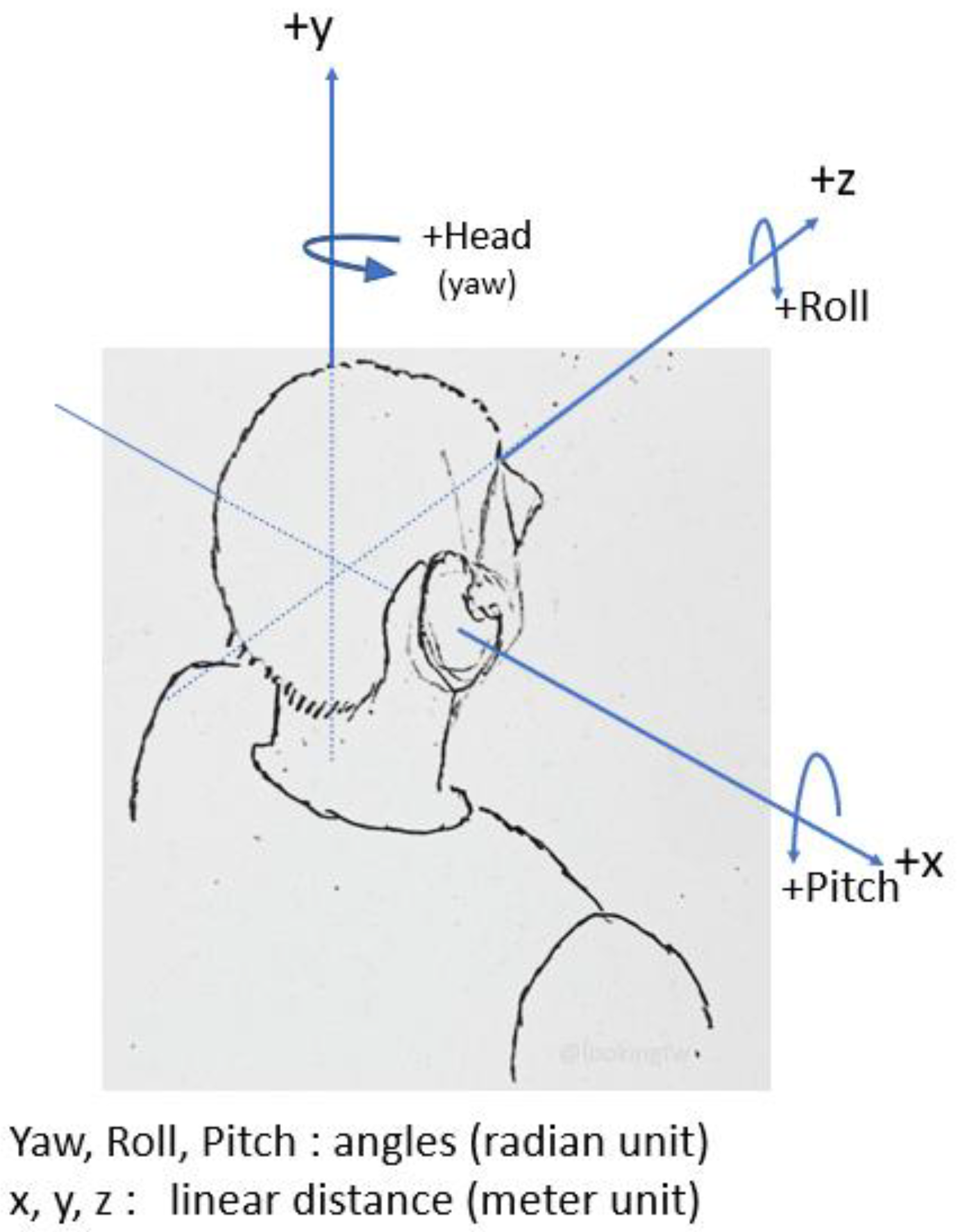



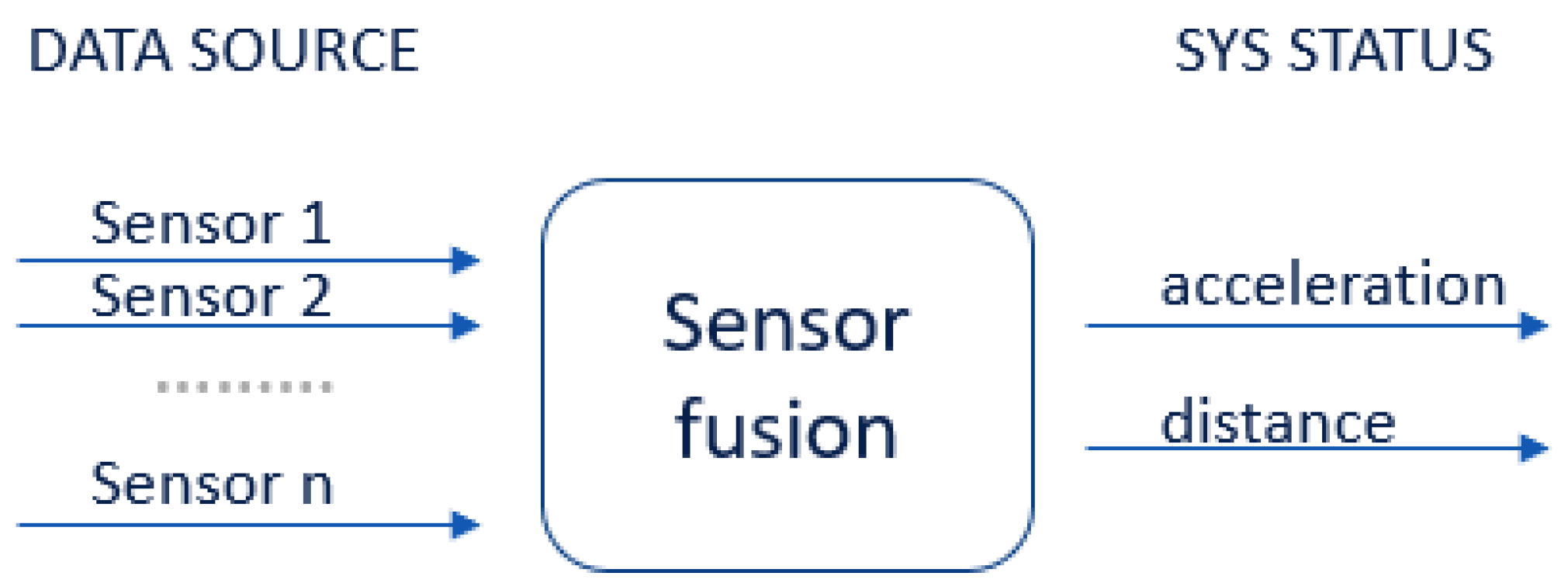



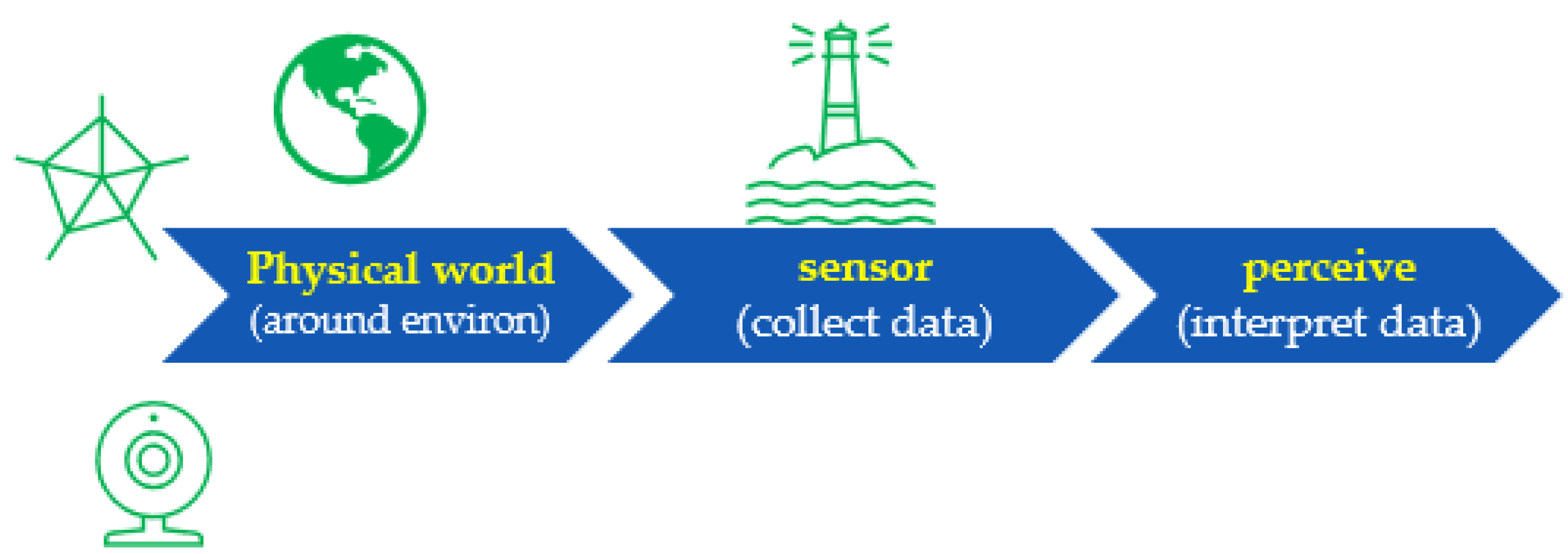




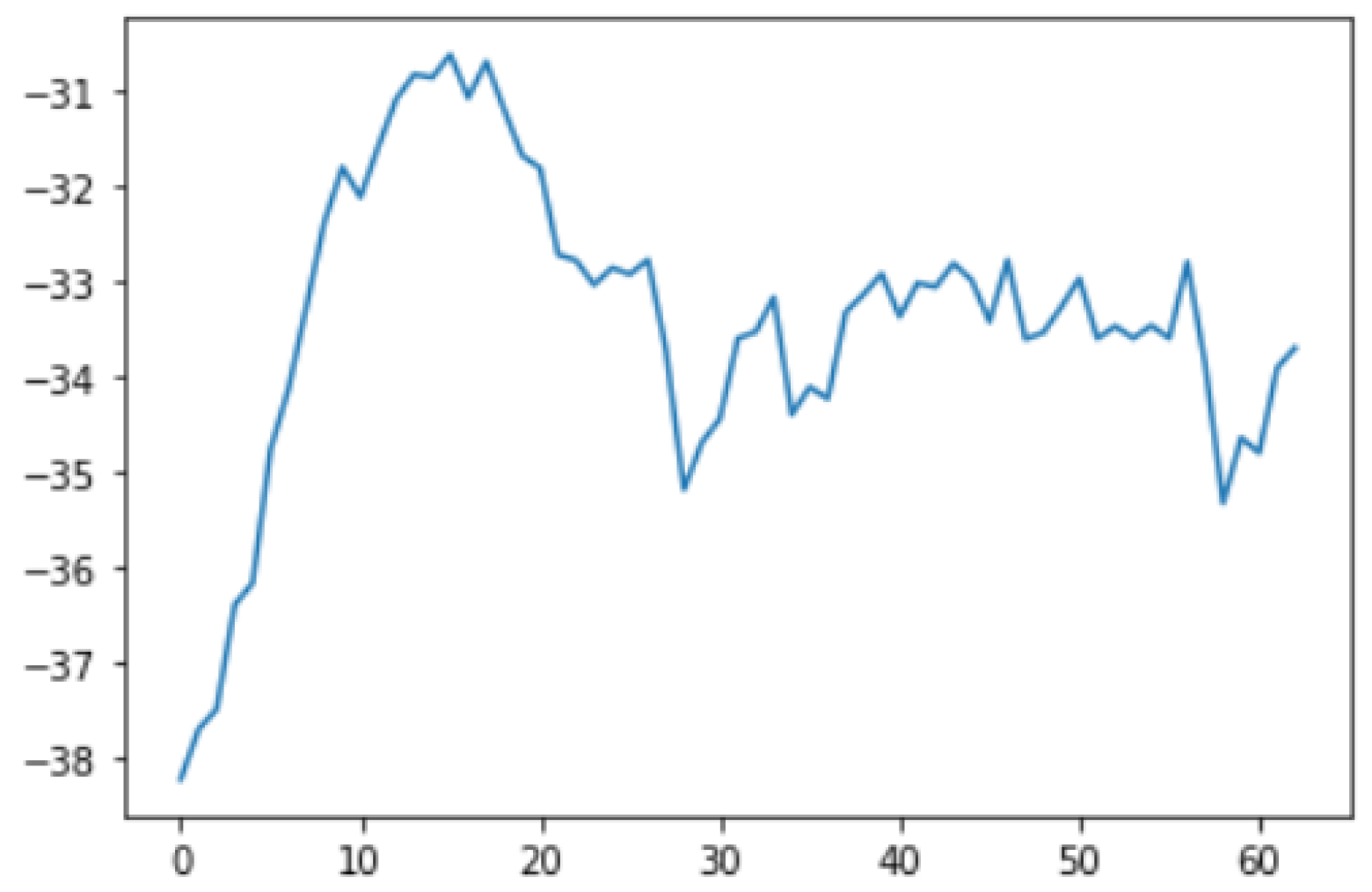

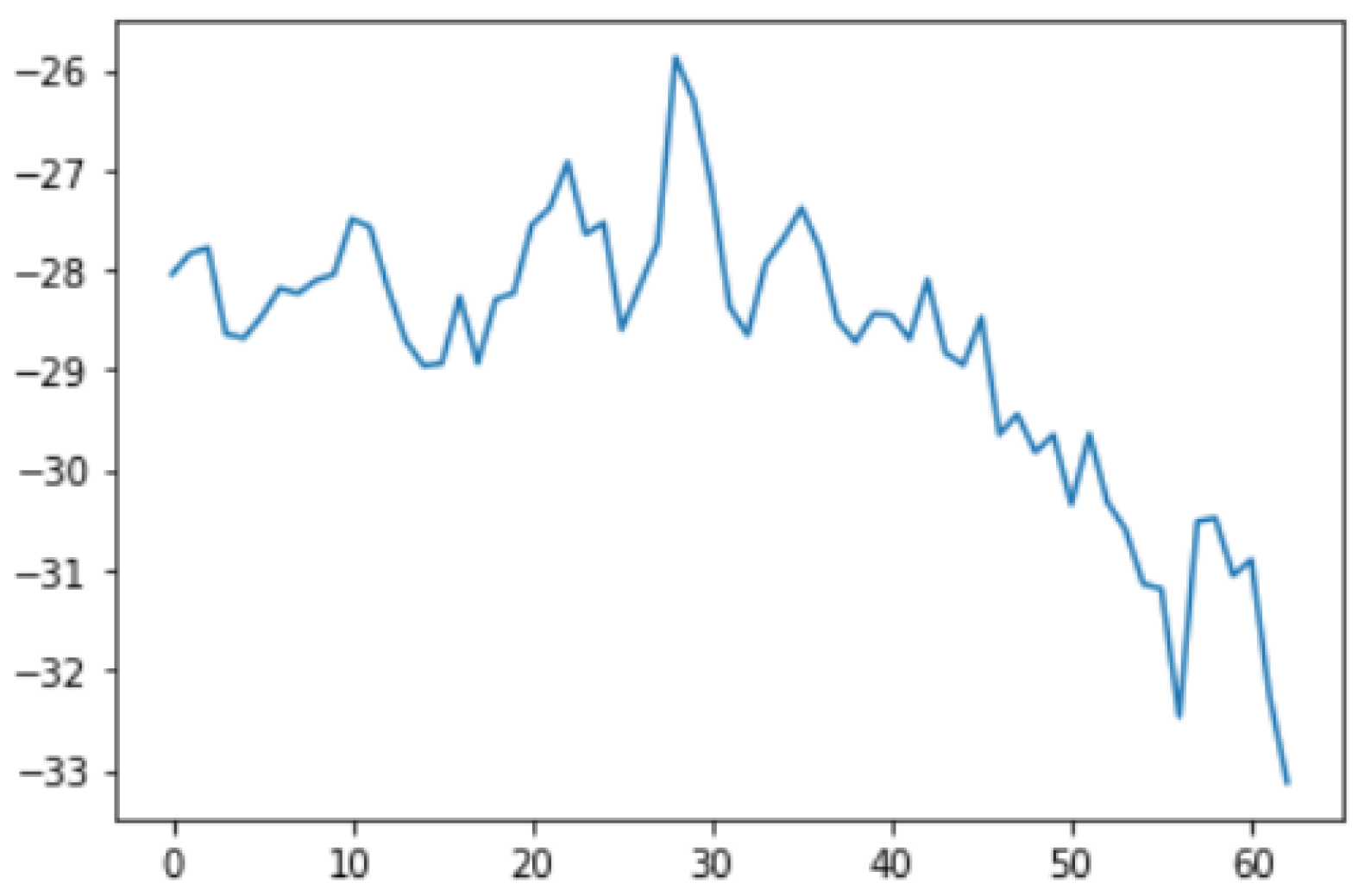









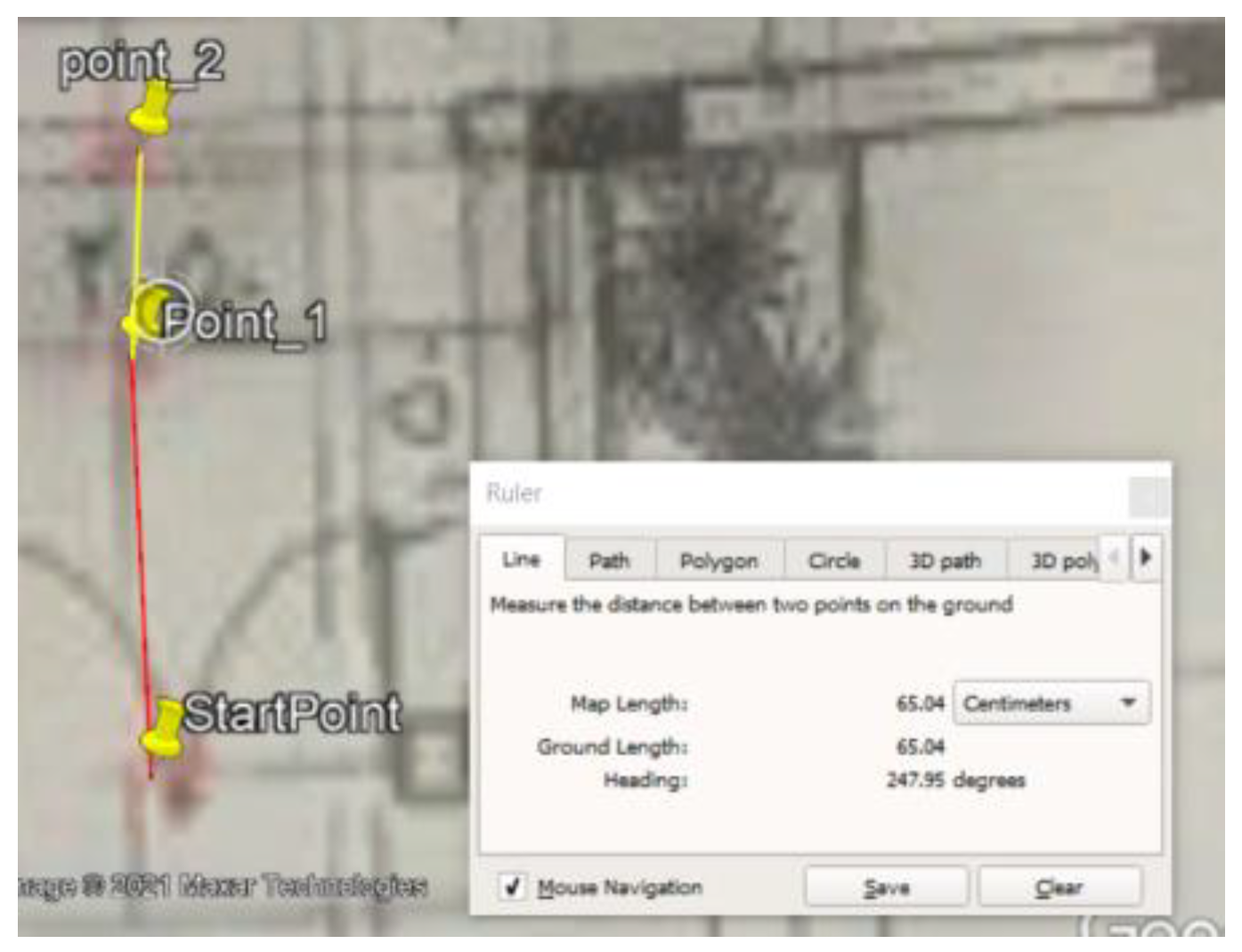

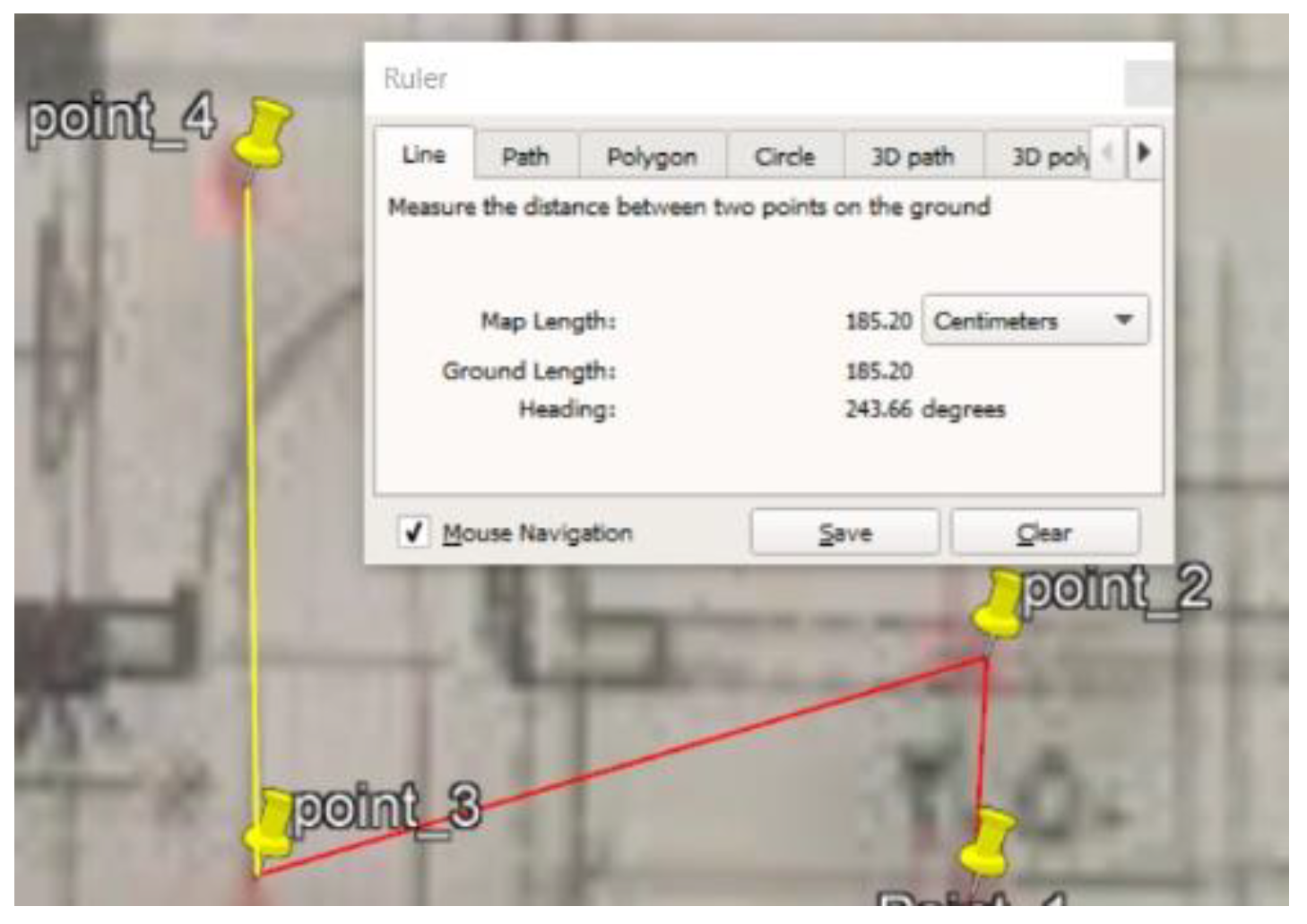




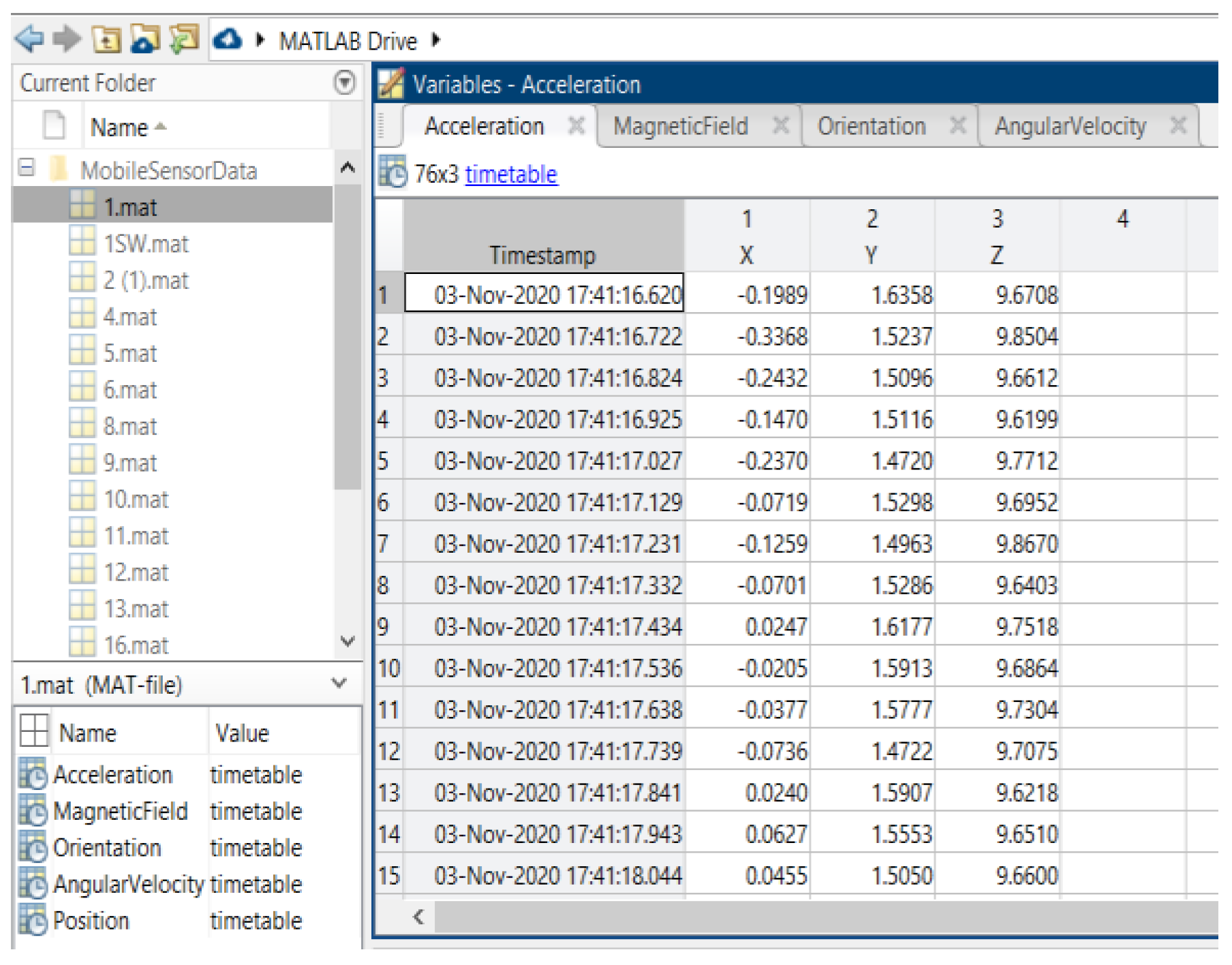
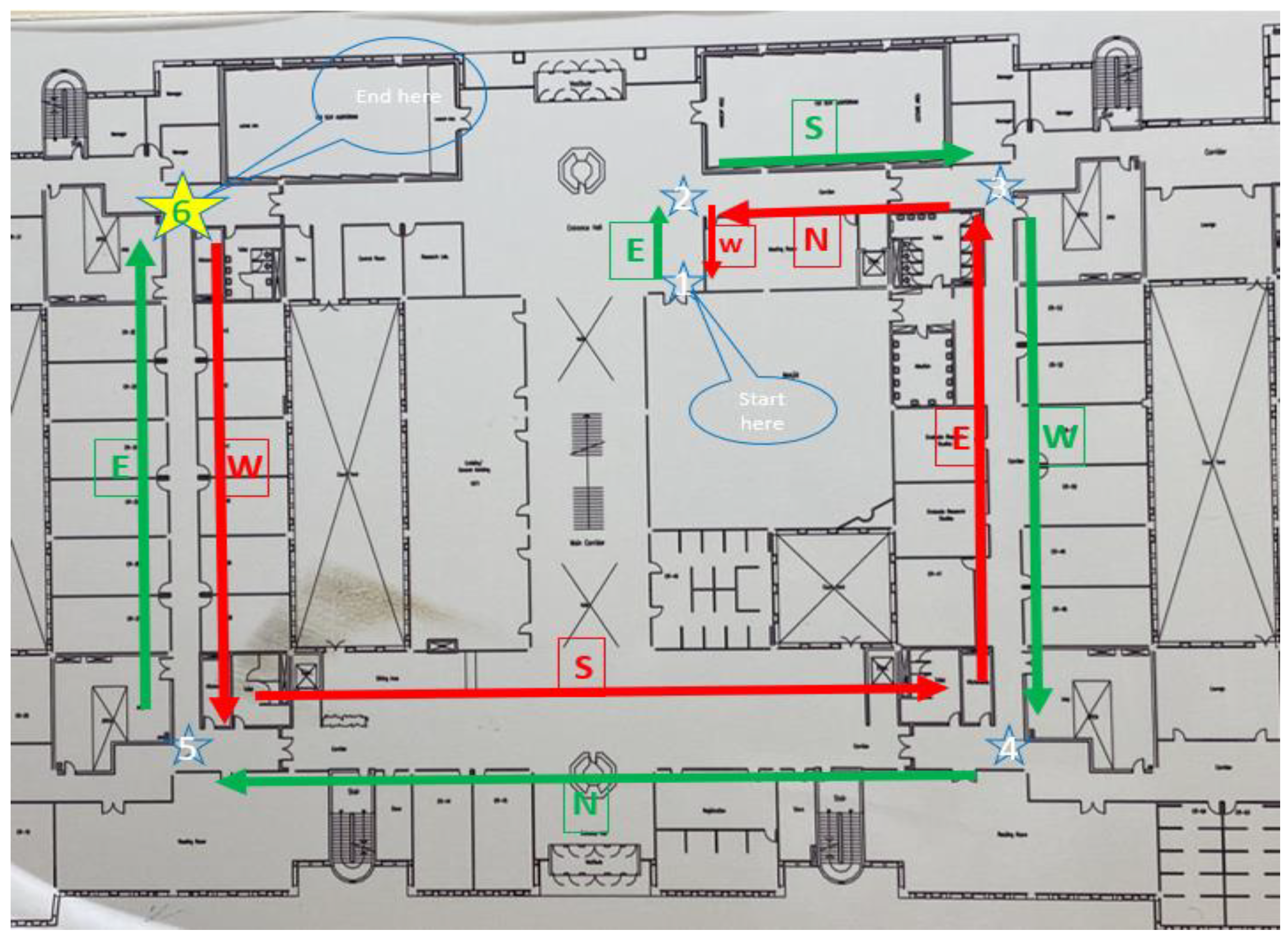


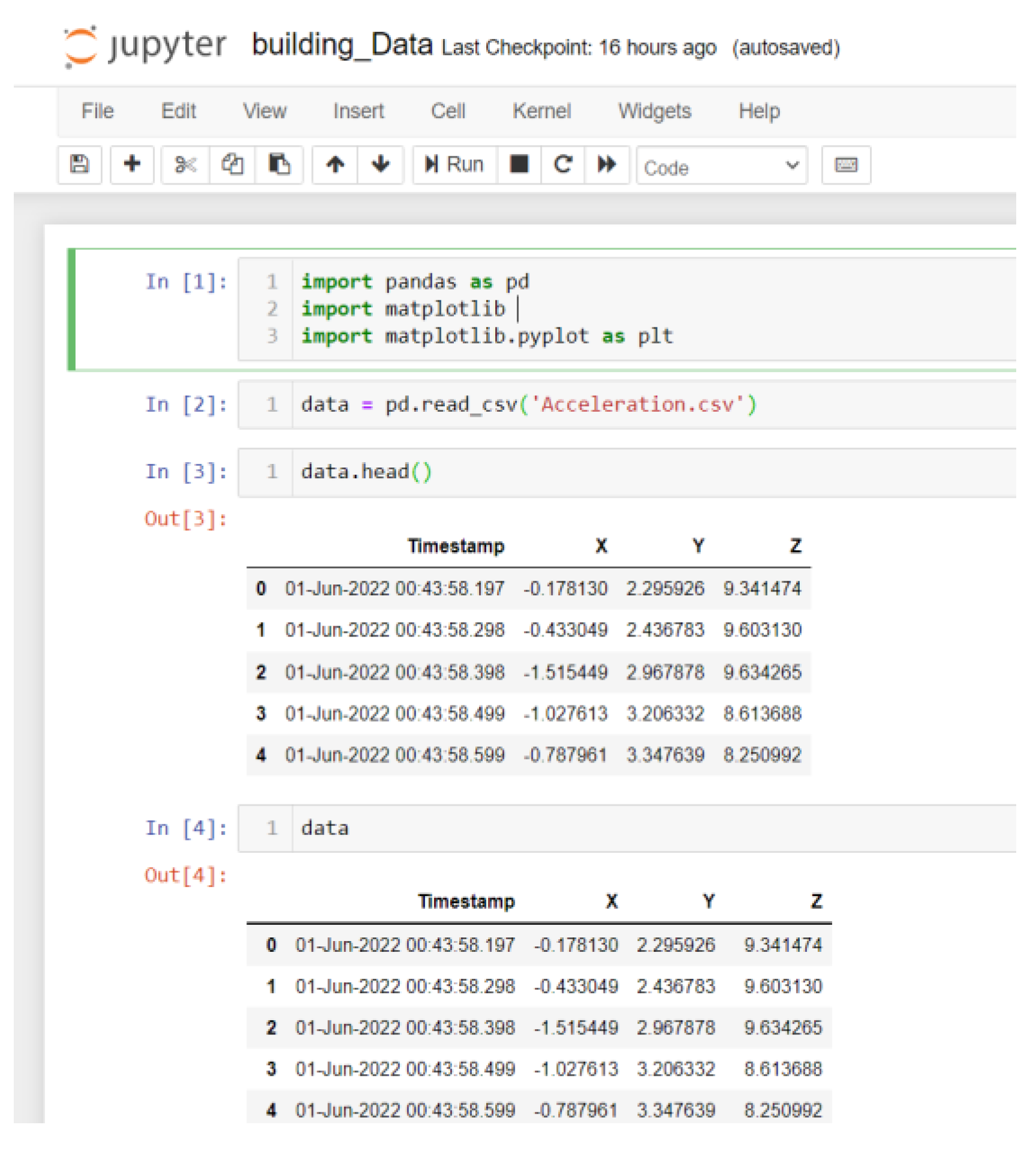






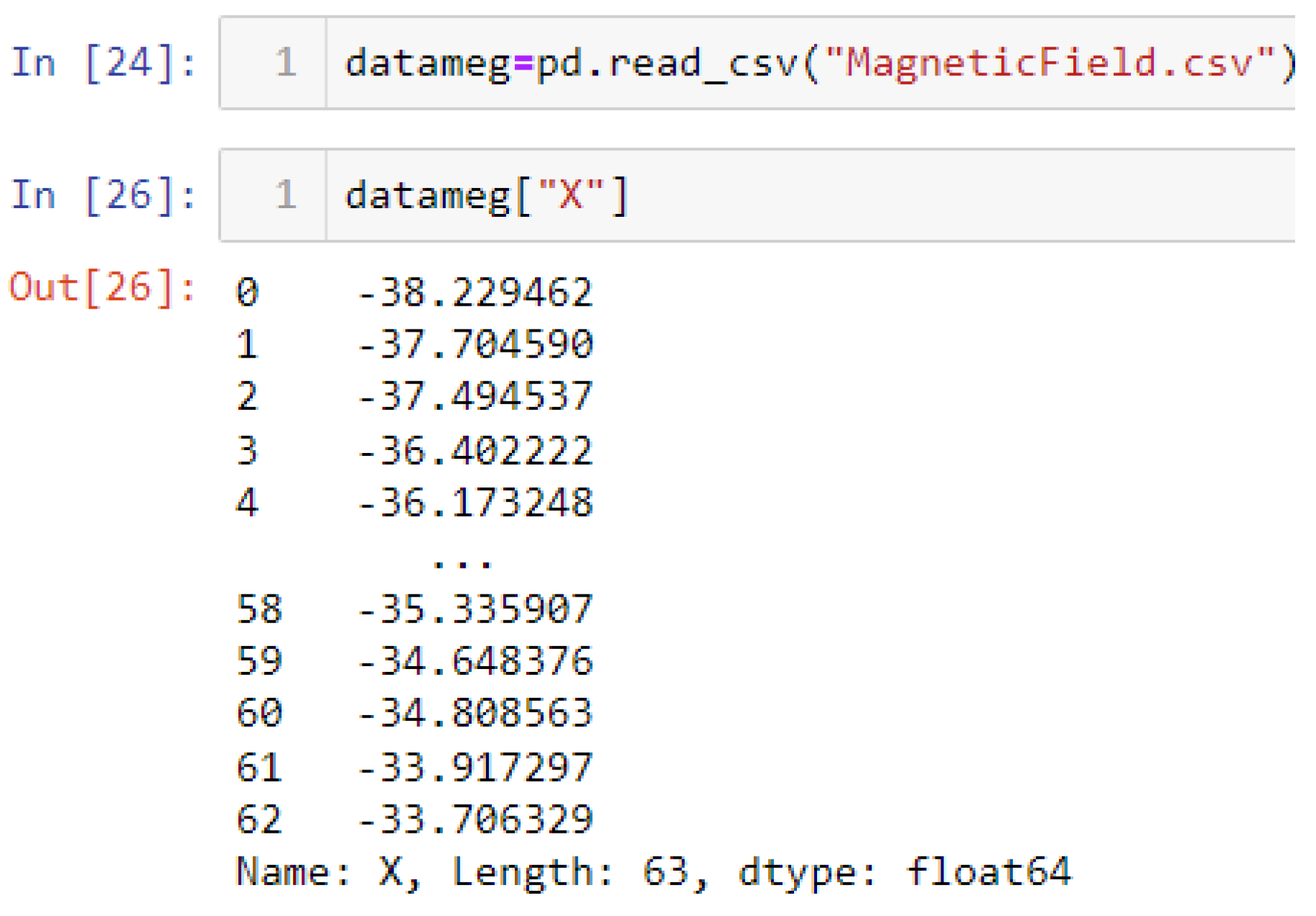









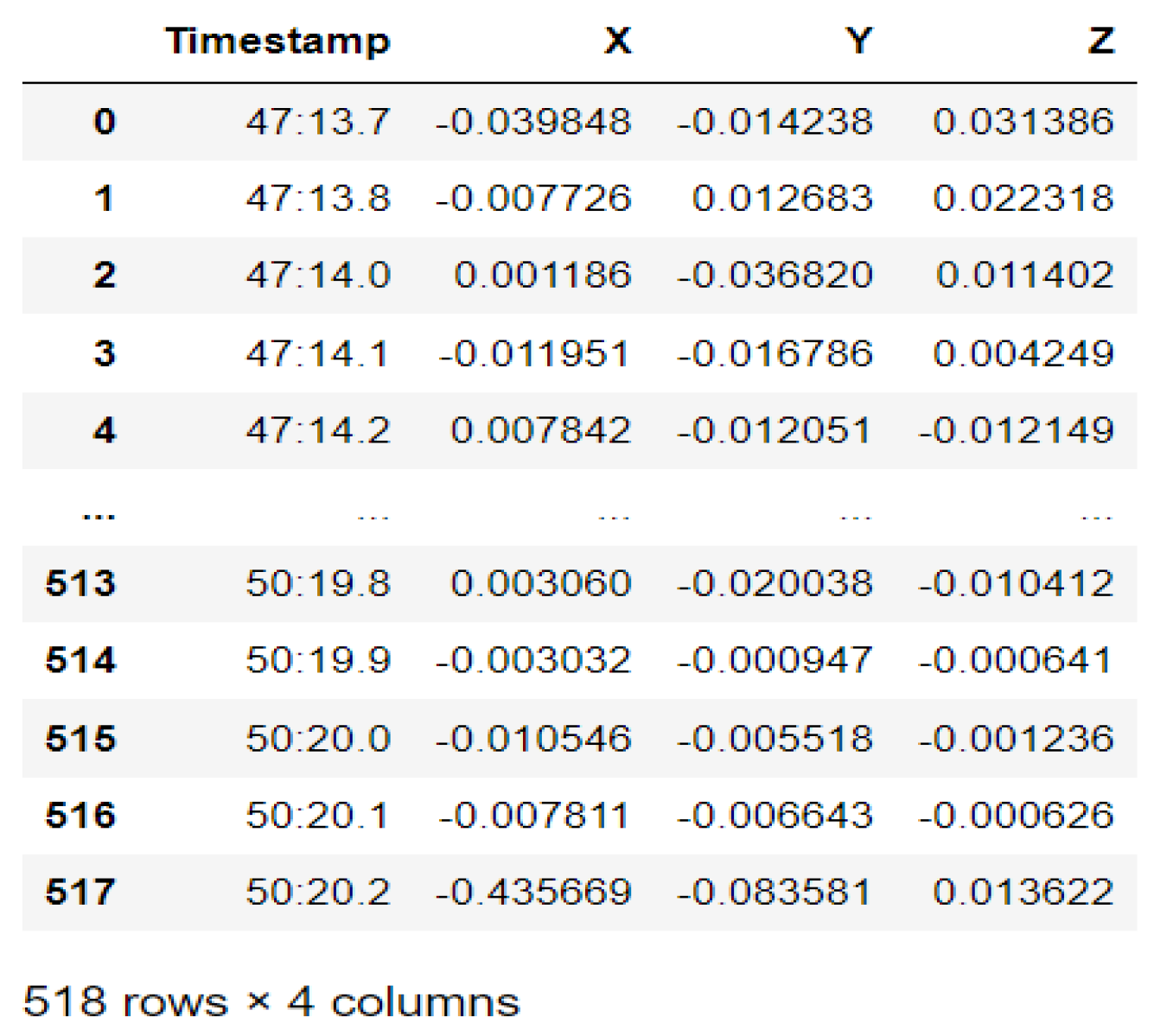
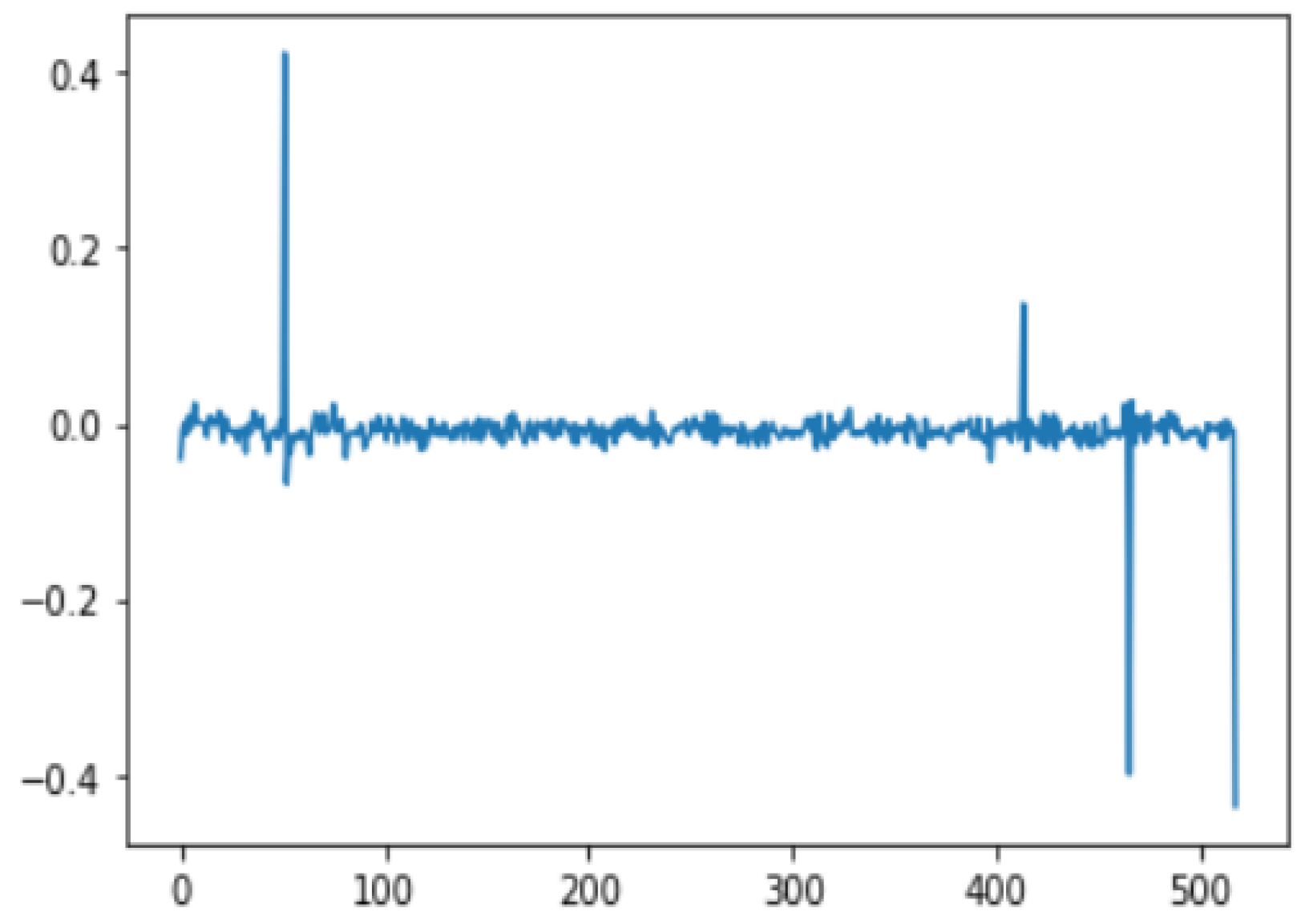
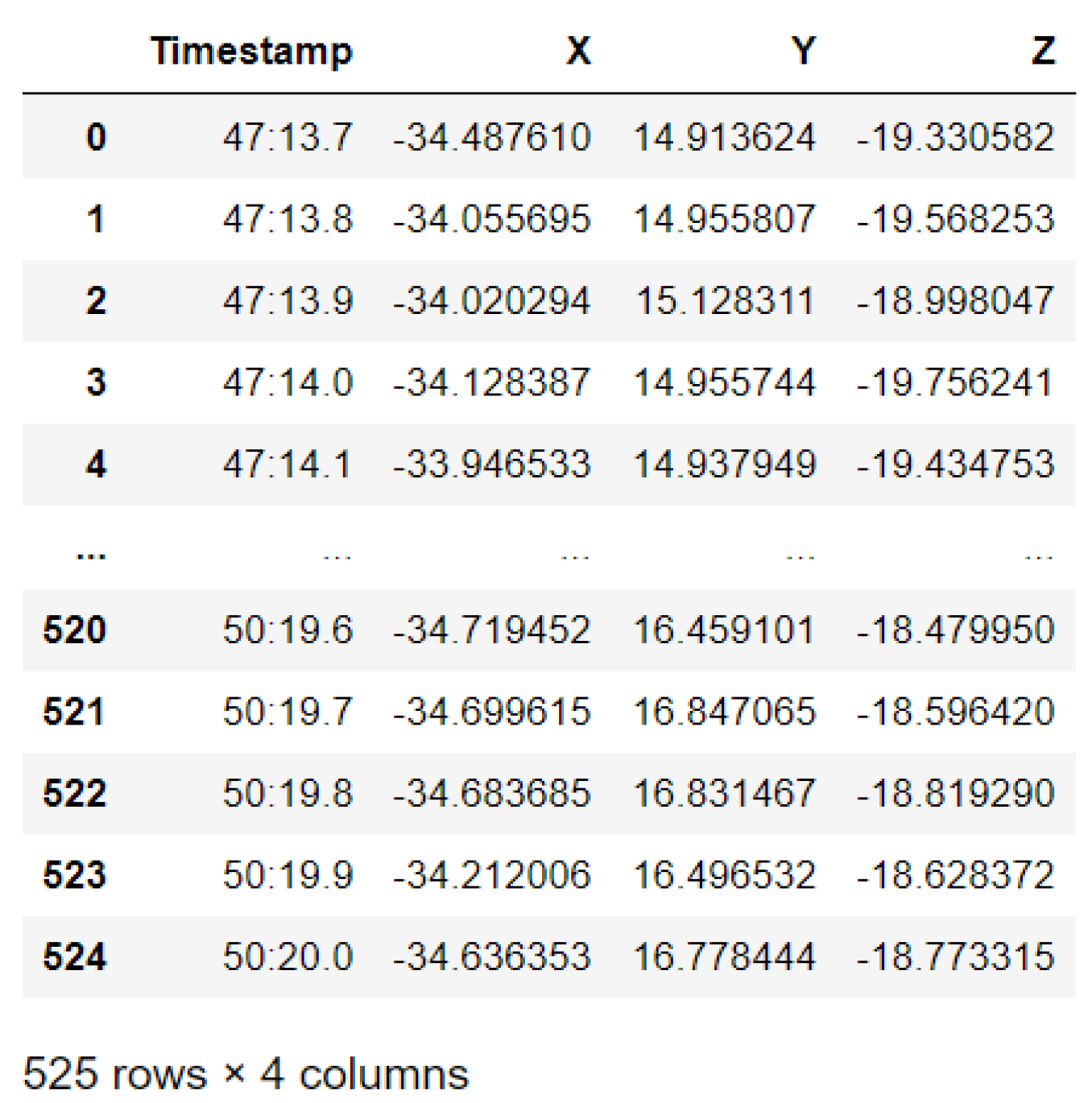



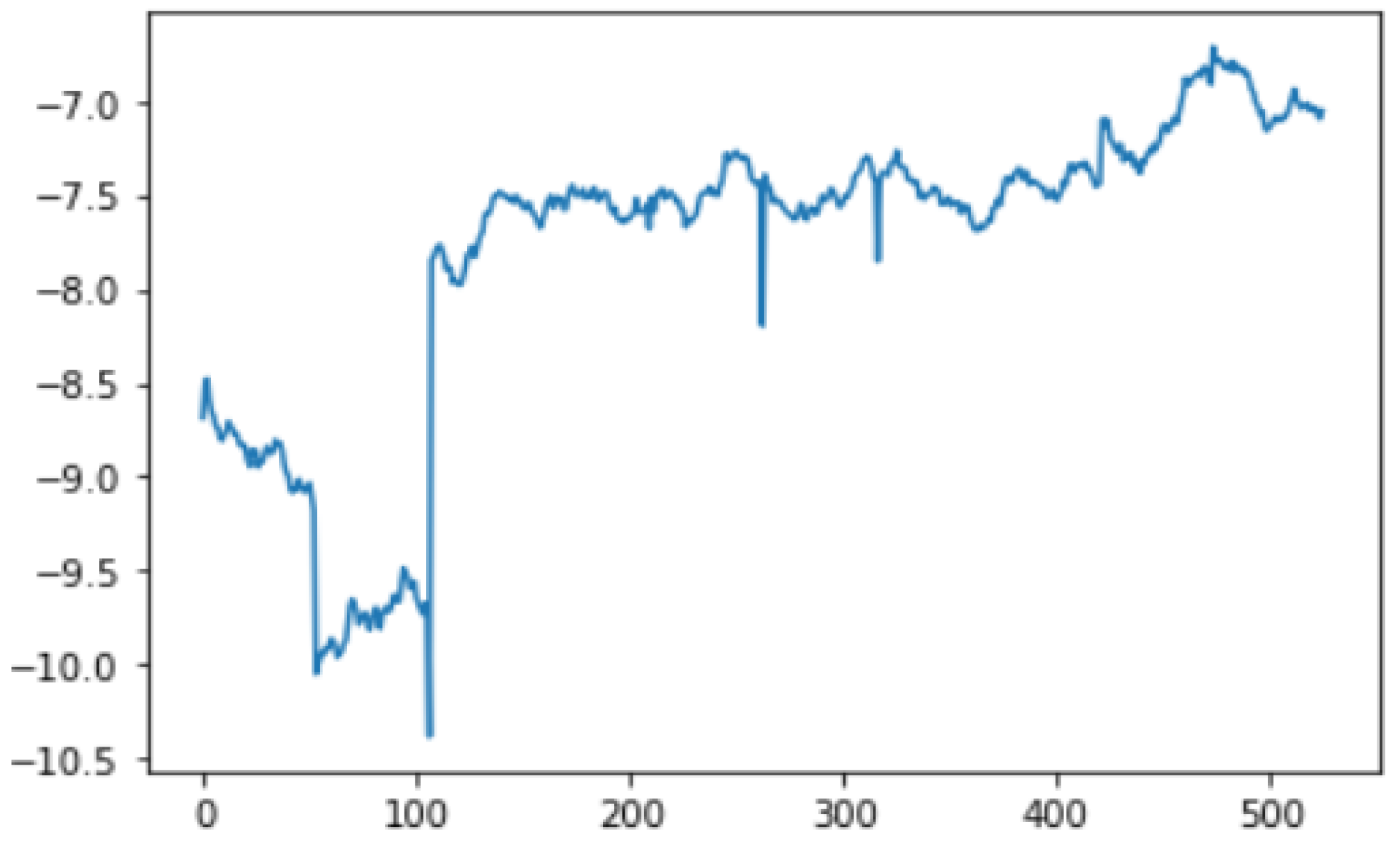
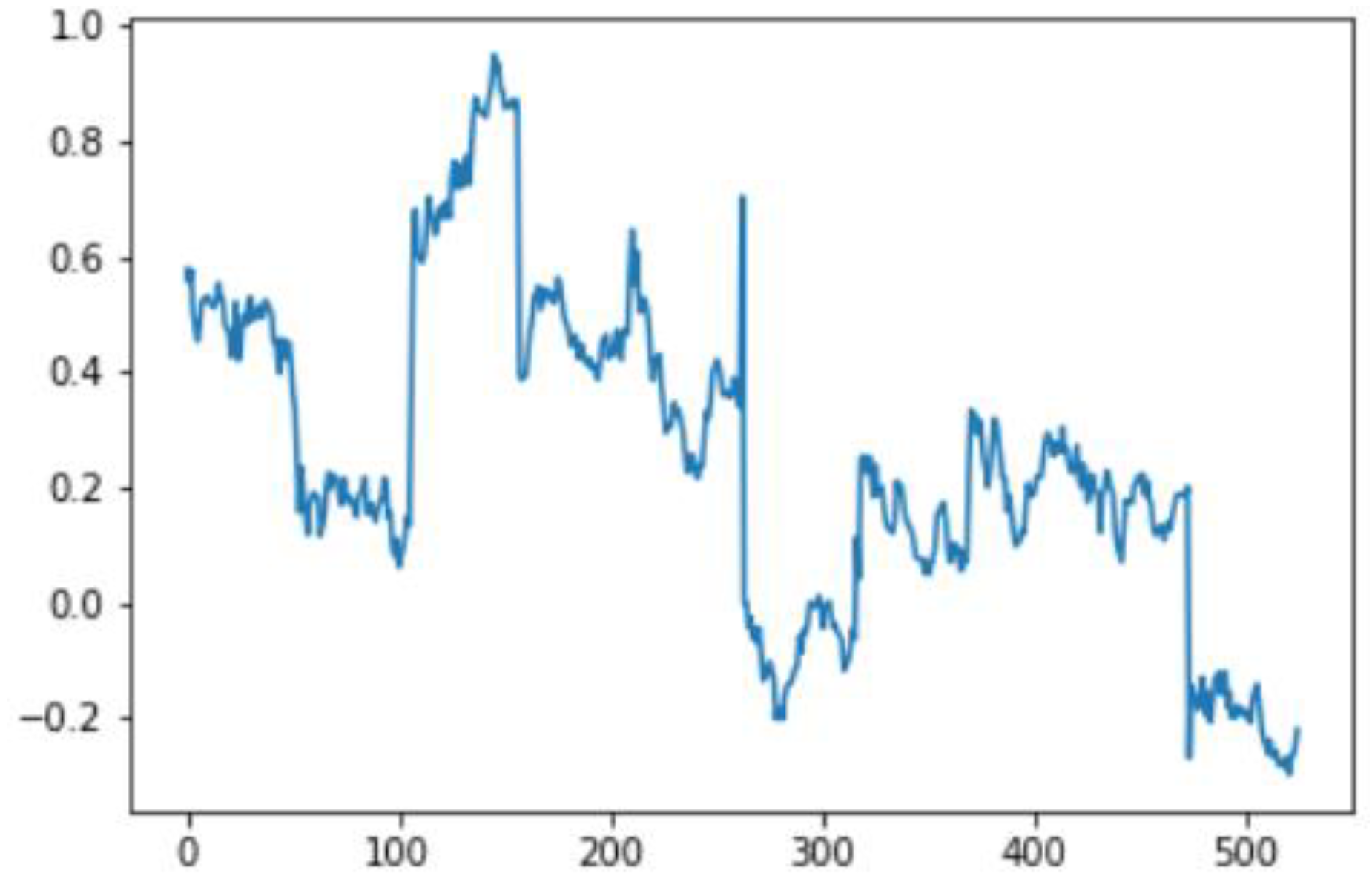





| Algorithm | Uses | Limitations |
|---|---|---|
| Support-vector machine (SVM) [26,55,56] | Good when merging of high-dimensional data is needed or when the number of dimensions is greater than the number of samples. Utilizes memory. Good for predicting noise from gyro sensors. Efficient for long-term navigation. | Not good with large and noisy datasets. Time-intensive. |
| Kalman filter [16,21,34,35,39] | Correct IMU-based trajectory. Presented as an alternative sensor for vehicle localization. Less sensitive to variations. Able to obtain smooth and accurate results. | Low accuracy when fusing some data. Requires initial value to begin. Cannot save anything except the previous value. |
| Sequence alignment algorithms [57] | Work well with pedestrian dead reckoning. | Data drift when moving. |
| Complementary filter [34,35] | Works well when coupled with MEMS IMU. Fusion technique. Consists of low- and high-pass filters. | Does not consider statistical description of the noise corrupting the signals. Hard with tuning fusion data. |
| Low-pass filter [34,35] | Used for smoothing datasets. Removes short-term fluctuations. | Measurements become less accurate with time. |
| High-pass filter [35] | Removes high-frequency noise from sensors. | Lag problem. |
| Particle filter [16,34] | Spreads multiple particles to indicate locations. Weight function used to describe the important estimated locations. | Relative location. |
| Weighted consensus algorithm [58] | Allows devices to self-learn the common channel parameters | . |
| Weighted centroid algorithm [6,7] | Inherits characteristics of a relatively simple operation. Analyzes sources of error unevenness. | Needs number of anchors, localization. |
| Geo-fencing function [29] | Determines object topology relation. | Needs established hardware infrastructure and access points. |
| Bi-iterative [14] | No need to learn about environment. Compares mobile location with virtual sensor. | Needs objects to compare with. |
| ACASIM/ACOSIM [11] | Clustering based on similarity. Used when there is no physical distance between nodes. | |
| U-Net [59] | Focuses on a virtual thermal infrared radiation (IR) sensor. Estimation of thermal IR images can enhance the terrain classification ability. | Crucial for autonomous navigation of rovers. |
| Monte Carlo localization [60] | Saves energy to localize robot. Estimates position and orientation. | Needs wireless device supplementations. |
| Active noise control [61] | Can make a quiet zone at a location. | RF required. |
| Quaternion [35] | Good in trackball-like 3D. Provides (cos theta, sin theta) vector. | Does not multiplicatively commute. |
| Direct cosine matrix (DCM) [35] | Can transform coordinate frame from one system to another. | Limited to 3 × 3 matrices. |
| Hidden Markov model [16] | Joint probability between the states and observation. Represents transition, emission, and initial distribution. | Limited accuracy under high data noise. High computation consumption to identify compatibility between state and observation. |
| Savitzky–Golay algorithm [62] | Reduces high noise by iterating multi-round smoothing and correction. | High computation. |
| Fast Fourier transform (FFT) [63] | Highly reliable when considering time-series data; high speed, which reduces computation time. | Integral over time, consuming process time. |
| Technology (Application) | Advantages | Disadvantages |
|---|---|---|
| Fingerprinting [65,66] |
|
|
| LiDAR-based tracking applications [67] |
|
|
| Lateration [57] |
|
|
| Phased array antenna/antenna array [68] |
| – Requires effort for design and installation. |
| Pedestrian dead reckoning (PDR) [21,57,69,70,71] |
|
|
| Path matching [57] | Takes recorded steps and step heading, and makes corrections using an algorithm (e.g., First Fit, Best Fit). |
|
| Magnetic-field-based positioning [25] |
|
|
| Magnetic induction (MI) technique [25] |
|
|
| UbiCare’s system (uses stereo vision algorithm) [41] |
|
|
| Angle of arrival (AoA) [65] | – Provides high localization accuracy without fingerprinting. | – Needs additional antennas and complex hardware, as well as algorithms. |
| Time of flight (ToF) [65] | – Provides high localization accuracy without fingerprinting. |
|
| Time difference of arrival (TDoA) [65] |
| – Needs large bandwidth. |
| Zero-velocity update (ZUPT) [72] | Mounts IMU on foot to suppress drift results from error accumulation from the inertial integration method. | Data from IMU strapped on upper limb will not observe the zero-velocity phase. |
| RFID [69] | Personnel tracking. Monitors objects. Provides data about objects. | Relies on other apparatus (e.g., sensors, tags, AP, LED light). |
| Indoor positioning system (IPS) [69,73] | Helps visitors to navigate through indoor environments. | Mounted Bluetooth locator beacons or sensors in fixed places. Cost, time, and computation. |
| UWB [69,73] | Great accuracy in line-of-sight (LOS) conditions. | Suffers in non-line-of-sight (NLOS) conditions. Signals are degraded due to attenuation. |
| Wi-Fi [69,71,74] | Indoor localization. | Relies on other apparatus (e.g., sensors, tags, AP, LED light). |
| Wi-Fi signal with magnetic field data [71] | Uses two-pass bidirectional particle filter process to enhance positioning. | Suffers from particle degradation problem. |
| Visible light [69] | Indoor localization. | Relies on other apparatus (e.g., sensors, tags, AP, LED light). |
| Ultrasound [69] | High positioning accuracy. | High installation and maintenance costs. |
| SLAM-based post-process smoothing [74,75] | – Suitable for large-scale positioning. | – Requires extra hardware mounted on user and smartphone. |
| Particle-filter-based map-matching [47] | – Refines the trajectories estimated by the PDR algorithm. | – Map data need to be imported in advance. |
| Sequence-based magnetometer matching positioning (SBMP) [71] | Measures similarity of the magnetic data used in mobile phones. |
|
| Single point-based magnetic matching positioning (SPMP) [71] | No limitation on speed or trajectory of pedestrian. – More flexible. | – Needs particle filter algorithm to compensate for this limitation and improve positioning accuracy |
| Hausdorff distance [76] | Controls initial position error. Accelerates the convergence speed of the filter. | Limited to long-range scenarios. |
| Exponential moving average (EMA) [77] | One of the most common smoothing methods. Provides accurate results. | Must calculate data from the beginning each time when smoothing. |
| Paper | Technique | Idea/Solution | Algorithm | Sensors | Accuracy |
|---|---|---|---|---|---|
| [79] | Fingerprints | Easy to train and deploy. Wi-Fi localization methodology. | GMM clustering and random forest ensembles. | Access Points, Wi-Fi, RSS. | 97% room accuracy from room center. |
| [80] | Light fingerprints | Utilizes electronic differencing in construction of compact fluorescent light and light-emitting diode bulbs. | Fast Fourier transform (FFT) (primary); k-nearest neighbors (kNN), CNN classifier. | Raspberry Pi, light sensor, ADC, battery. | 76.11%. |
| [81] | Dead reckoning with instantaneous speed and heading | Utilizes aerodynamic fluid computation for instantaneous speed of heading of a smartphone. | Dedicated computational algorithm. | LBA series sensor from SensorTechnics GmbH company, anemometer, gyroscope. | SD of less than 6% in distance travelled. |
| [82] | Magnetometer fingerprints | Determines occupancy based on conversing with the environment. | Speaker estimation algorithm based on unsupervised clustering; change point detection algorithm. | Acoustic sensors, magnetometer. | 0.76 error count in distance. |
| [83] | Time-difference-of-arrival (TDoA)-based | Utilizes acoustic localization. | Cumulative density function (CDF). | Acoustic signal, RF, nodes, access points, ultrawide-band beacon nodes. | 95% quantile localization errors in less than 7.5 cm, when closest two anchors are 1 m apart. |
| [36] | Decision tree | Localizes user in 1–1.5 m radius. | DNN in decision tree. | No hardware. | 74.17% within 1.5 m and 53% (approx.) within 1 m. |
| [43] | Geomagnetic observations | Uses corners and spots with magnetic fluctuations for localization. | Uses hidden Markov model (HMM). | Acce, mag. | Error of less than 8.7 ± 6.1 m. |
| [84] | Walking pattern classification | Walking feature detection based on time. | Extended Kalman filter. | Waist-mounted 9DoF IMU + Acce, gyro, mag. | Room accuracy level. |
| [85] | ML algorithm + smart sensor management | Energy consumption analysis; LearnLoc app. | Algorithms: k-nearest neighbors (kNN), linear regression (LR), nonlinear regression with neural networks (NL-NN). | APs, Wi-Fi, acce, mag, gyro. | 1–3 m accuracy. |
| [86] | Magnetic field fingerprinting with PDR | Using magnetic field to localize and find a pedestrian pattern fingerprint | Algorithm: k-nearest neighbor (kNN) approach. | Acce, gyro, mag (primary). | Overall localization within 1.21 m is50% and within 1.93 m is 75%. |
| [78] | Fingerprint for merging different sources of environmental data to locate user | Use three sources (microphone, magnetometer, and light) with the signals available in the building. | Multivariate models used as an information fusion technique. | Microphone, magnetometer, light sensor. | 73% room-level accuracy. Sensitivity 22% and specificity 2%. |
| [57,81] | Path-matching technique | Localizes user route. | Algorithms (First Fit, Best Fit); multifit algorithm to correct steps and step heading; sequence alignment algorithms from the field of bioinformatics. | Mobile camera, acce, compass, step counts. | Average error less than 3 m. |
| [87] | Map-matching is proposed | Combining dead-reckoning estimation with map-matching in buildings. | Hidden Markov model (HMM) theory and tailored to map-matching technique algorithm: HMM. | Foot-mounted dead-reckoning system | Error lower than 3 m 69.2% of the time + reduced computational cost. |
| [88] | Magnetic field disturbance and ambient light | Help people to get their bearings when in buildings. | Using geomagnetic field disturbances + ambient light; algorithm: particle filter (to fuse + track mobile data). | Magnetic ambient light. | Mean error of 4 m. |
| [89] | SMART: simultaneous map acquisition and repeated tracking | Subject-based sensor and radio signal to detect environmental fingerprints. | Algorithm: particle filter. | AP, Wi-Fi, camera, microphone, acce, mag. | Constructs environment maps with 89% accuracy on average, compared with dead reckoning. |
| [22] | Fusion IMU sensor and user context | Using OpenStreetMap, fuse IMU and map information for indoor localization. | Algorithm: particle filter (primary algorithm); support-vector machine classification model. | Acce; pressure sensor. | Median error of 2.3 m in real time. |
Publisher’s Note: MDPI stays neutral with regard to jurisdictional claims in published maps and institutional affiliations. |
© 2022 by the authors. Licensee MDPI, Basel, Switzerland. This article is an open access article distributed under the terms and conditions of the Creative Commons Attribution (CC BY) license (https://creativecommons.org/licenses/by/4.0/).
Share and Cite
AlSahly, A.M.; Hassan, M.M.; Saleem, K.; Alabrah, A.; Rodrigues, J.J.P.C. Handheld Device-Based Indoor Localization with Zero Infrastructure (HDIZI). Sensors 2022, 22, 6513. https://doi.org/10.3390/s22176513
AlSahly AM, Hassan MM, Saleem K, Alabrah A, Rodrigues JJPC. Handheld Device-Based Indoor Localization with Zero Infrastructure (HDIZI). Sensors. 2022; 22(17):6513. https://doi.org/10.3390/s22176513
Chicago/Turabian StyleAlSahly, Abdullah M., Mohammad Mehedi Hassan, Kashif Saleem, Amerah Alabrah, and Joel J. P. C. Rodrigues. 2022. "Handheld Device-Based Indoor Localization with Zero Infrastructure (HDIZI)" Sensors 22, no. 17: 6513. https://doi.org/10.3390/s22176513
APA StyleAlSahly, A. M., Hassan, M. M., Saleem, K., Alabrah, A., & Rodrigues, J. J. P. C. (2022). Handheld Device-Based Indoor Localization with Zero Infrastructure (HDIZI). Sensors, 22(17), 6513. https://doi.org/10.3390/s22176513











